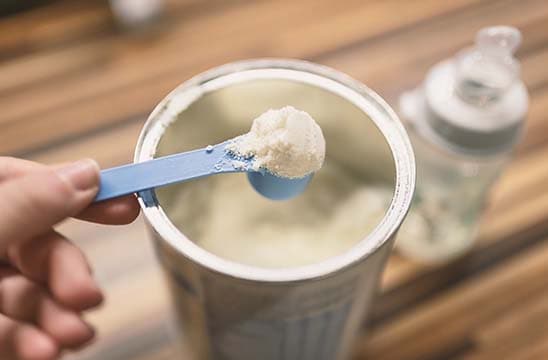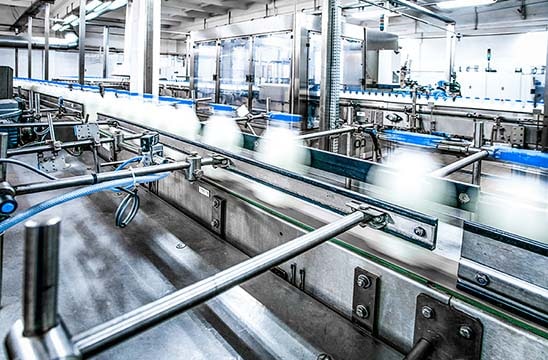Milk: The essentials
Milk is a natural source of the fats, minerals, nutrients, micronutrients, and vitamins required for a balanced diet. It is also essential for the growth and development of babies and infants into early childhood. Young children between the ages of one and three are recommended to have an intake of 350-400 mL of milk daily to ensure they receive the correct quantity of this nutrient.1
Either breast or infant formula milk is given to babies for at least the first six months of their lives, and between the ages of one and two years, whole milk and dairy products are recommended to ensure that babies receive essential vitamins they may not otherwise obtain from lower fat alternatives.2

A look at the global dairy market
The global dairy market is expected to reach a compound annual growth rate (CAGR) of 5% by 2025, with the milk segment dominating in sales.3 In 2018, the value of global milk production increased by 2.2% to 843 million tons from the previous year as production grew in South Asian, European, and North and South American regions despite a decline in milk output across China and Ukraine during this period.3
Given market growth in the global dairy industry, the future of milk and other dairy products is relatively unpredictable. Nevertheless, while its trade is ongoing and set to rise over the next four years, testing the nutritional values, safety, and authenticity characteristics of milk and dairy is pivotal for both consumers and producers.
Preserving nutritional values, safety, and authenticity
Milk and its related products are tested for three main reasons within the food and beverage industry:
- Nutrition — ensuring the required nutritional value of milk is present in its products.
- Safety — confirming the absence of suspected harmful chemicals in milk.
- Authenticity — determining if milk products are adulterated and therefore compromised in any way.
By testing these three factors, consumers are more protected from mislabelled, fraudulent, and potentially contaminated milk products that may have reached the marketplace unregulated.
The importance of testing nutritional values of milk and infant formulas
Testing the nutritional values of milk is important so that consumers can make informed decisions about their purchases. Above all, manufacturers of specified products—such as infant formulas for example—must adhere to uncompromising nutritional values determined by regional, national, or international regulatory bodies.

To support consumers making these decisions about their milk and/or infant formula purchases, it is crucial for manufacturers to label their products accurately. In doing so, food testing labs may carry out experiments using HPLC, LC/MS/MS, and GC systems to accurately measure milk content for sugars, fats, vitamins, and amino acids.
Measuring the levels of vitamins as well as beneficial (and some essential) elements such as sodium, potassium, magnesium, calcium, selenium, phosphorus, manganese, and zinc, provides insightful nutritional information. It’s also important to monitor for potentially toxic elements such as arsenic, cadmium, tin, mercury, and lead in animal-derived milk as contamination could originate from animal feed, fertilizer, soil, or processing equipment.
In one study, the Agilent 5800 VDV ICP-OES system used with an SPS 4 autosampler determined calcium, copper, iron, potassium, magnesium, manganese, sodium, phosphorous, and zinc in milk powder and infant formula samples according to the ISO 15151 method.4 Results showed that the recoveries for all analytes with certified or reference values were within ±10% of the expected value, thus confirming its nutritional labelling.4
Other experimental examples include the rapid analysis of major and trace elements in milk and milk products using an Agilent 7900 ICP-MS with optional Ultra High Matrix Introduction UHMI technology and Integrated Sample Introduction System (ISIS 3).5
Examining the safety of milk

Foods of animal origins such as dairy milk go through additional scrutiny to detect levels of veterinary drugs. Without a sophisticated approach for testing dairy milk samples, analytical challenges are likely to arise due to the complexity of the matrix and the number of pharmaceutical analogues needed to monitor. Furthermore, the different legislative requirements of various countries require sample referencing that meets a wide variety of regulatory conditions.
Agilent provides generic extraction protocols using LC/MS (including an LC/MS Veterinary Drug Application Kit) solutions that effectively detect a range of veterinary drugs, metabolites, and transformation products in milk and other foods of animal origin. LC, SFC, and GC techniques are also used to determine molecular components and advanced sample preparation ensures the efficiency of all techniques.
Another factor to consider when examining the safety of milk is the responsible use of pesticides within established limits in animal feeds from which dairy milk is extracted, and in other plant-based ingredients which may be added to other milk products. To validate this, LC/MS, GC/MS, and Q-TOF workflows offer food testing labs the solutions needed to accurately measure pesticide levels in milk samples.
Furthermore, food safety studies are routinely conducted to detect, quantify, and validate trace-level analysis of undesirable byproducts such as chlorate and perchlorate in store-bought milk and infant formulas. In one particular study, the Agilent 1290 Infinity II LC and Ultivo triple quadrupole LC/MS (LC/TQ) was utilized.6 Data from this experiment highlights accurate quantitation at one tenth the level of the maximum residue level (MRL), which is 10 μg/kg in milk and infant formula as defined by the European Commission.6
Exposing fraudulent milk to preserve its authenticity
Globally, milk continues to be one of the most adulterated food and beverage products on the market.7 For example, in 2008 the analysis of dairy milk powder from Minhe Hui County, China, revealed the contamination of melamine—an organic compound used to manufacture fertilizers and concrete—to be 500 times the maximum limit of melamine found in test samples at that time.8

More recently in Southern Asia, the Punjab Food Authority seized almost 80,000 litres of milk to combat the adulteration of dairy products in the local metropolis. The milk was flagged due to the addition of urea and water.9
In addition to deceiving consumers and manufacturing producers, food fraudsters can seriously affect the health outcome of individuals. Fortunately, innovations in analytical instrumentation and testing methods are exposing these unlawful acts to reinstall consumer confidence by validating the authenticity and safety of products such as milk and infant formulas.
Agilent instruments and analytical methods are highly valuable in the investigation of food fraud—as mentioned in the cases above—and continue to support customers working on quality assurances and control within the food testing market.10
For example, the Agilent 8890 GC and the Agilent 5977B GC/MS single quadrupole mass spectrometer have been used to detect and quantify β-sitosterol in ghee (milk fat) samples to check for vegetable oil adulteration.11 The presence of β-sitosterol is associated with low quality and is a potential indicator of adulterated milk. Results showed that 2.24 ppm β-sitosterol was found in the ghee sample on which the study was performed.11
Both targeted and nontargeted approaches can be used to identify known compounds in milk and other food authenticity testing. The latter is beneficial if adulterants in milk are new or have not been previously identified by food testing labs. Nontargeted methods using quadrupole time-of-flight mass spectrometers for example, create a chemical fingerprint of authentic foods, making it more difficult for food fraudsters to cheat the global food supply chain.
Forming partnerships to eliminate milk fraud
As milk sale projections are estimated to increase over the next few years, and with wider varieties of product choice in stores and online, it is important that companies like Agilent continue to work in partnership with its food testing customers to eliminate the threat of milk fraud while preserving its nutritional values, safety, and authenticity. Above all, manufacturers of milk products must adhere to multiple food regulations relating to quality and safety which are constantly being updated. Agilent is here to support our customers so that consumers of their products have confidence in their purchase choice for the nourishment of themselves and their families.
Related Products